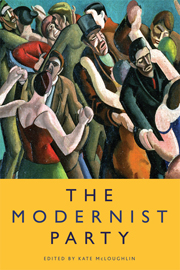Book contents
- Frontmatter
- Contents
- A Note of Thanks
- The Guest List
- Introduction: A Welcome from the Host
- 1 ‘The dinner was indeed quiet’: Domestic Parties in the Work of Joseph Conrad
- 2 Prufrock, Party-Goer: Tongue-Tied at Tea
- 3 Party Joyce: From the ‘Dead’ to When We ‘Wake’
- 4 ‘Looking at the party with you’: Pivotal Moments in Katherine Mansfield's Party Stories
- 5 Virginia Woolf's Idea of a Party
- 6 Proustian Peristalsis: Parties Before, During and After
- 7 ‘Ezra through the open door’: The Parties of Natalie Barney, Adrienne Monnier and Sylvia Beach as Lesbian Modernist Cultural Production
- 8 ‘Indeed everybody did come’: Parties, Publicity and Intimacy in Gertrude Stein's Plays
- 9 The Interracial Party of Modernist Primitivism and the Black ‘After-Party’
- 10 The Party In Extremis in D. H. Lawrence's Women in Love
- 11 Bohemian Retrospects: Ford Madox Ford, Post-War Memory and the Cabaret Theatre Club
- 12 ‘Pleasure too often repeated’: Aldous Huxley's Modernity
- Index
9 - The Interracial Party of Modernist Primitivism and the Black ‘After-Party’
Published online by Cambridge University Press: 05 April 2014
- Frontmatter
- Contents
- A Note of Thanks
- The Guest List
- Introduction: A Welcome from the Host
- 1 ‘The dinner was indeed quiet’: Domestic Parties in the Work of Joseph Conrad
- 2 Prufrock, Party-Goer: Tongue-Tied at Tea
- 3 Party Joyce: From the ‘Dead’ to When We ‘Wake’
- 4 ‘Looking at the party with you’: Pivotal Moments in Katherine Mansfield's Party Stories
- 5 Virginia Woolf's Idea of a Party
- 6 Proustian Peristalsis: Parties Before, During and After
- 7 ‘Ezra through the open door’: The Parties of Natalie Barney, Adrienne Monnier and Sylvia Beach as Lesbian Modernist Cultural Production
- 8 ‘Indeed everybody did come’: Parties, Publicity and Intimacy in Gertrude Stein's Plays
- 9 The Interracial Party of Modernist Primitivism and the Black ‘After-Party’
- 10 The Party In Extremis in D. H. Lawrence's Women in Love
- 11 Bohemian Retrospects: Ford Madox Ford, Post-War Memory and the Cabaret Theatre Club
- 12 ‘Pleasure too often repeated’: Aldous Huxley's Modernity
- Index
Summary
At these times, the Negro drags his captors captive. On occasions, I have been amazed and amused watching white people dancing to a Negro band in a Harlem cabaret; attempting to throw off the crusts and layers of inhibitions laid on by sophisticated civilization; striving to yield to the feel and experience of abandon; seeking to recapture a taste of primitive joy in life and living; trying to work their way back into that jungle which was the original Garden of Eden; in a word, doing their best to pass for colored.
(James Weldon Johnson, Along This Way)She wasn't, she told herself, a jungle creature. She cloaked herself in a faint disgust as she watched the entertainers throw themselves about to the bursts of syncopated jangle, and when the time came again for the patrons to dance, she declined.
(Nella Larsen, Quicksand)The Harlem Renaissance of the 1920s and 1930s, in some of the 1960s and 1970s Black Arts Movement critiques, was an artistic movement of African Americans frolicking with the oppressors. Whereas the salons and sociability of Gertrude Stein, Muriel Draper and other modernists have been celebrated as the gathering of kindred spirits, the Black Arts Movement's assessments of the Harlem Renaissance set it up as an interracial party or spectacle of assimilation, in which the self-determination of the Negro was constantly jeopardised.
- Type
- Chapter
- Information
- The Modernist Party , pp. 164 - 177Publisher: Edinburgh University PressPrint publication year: 2013



